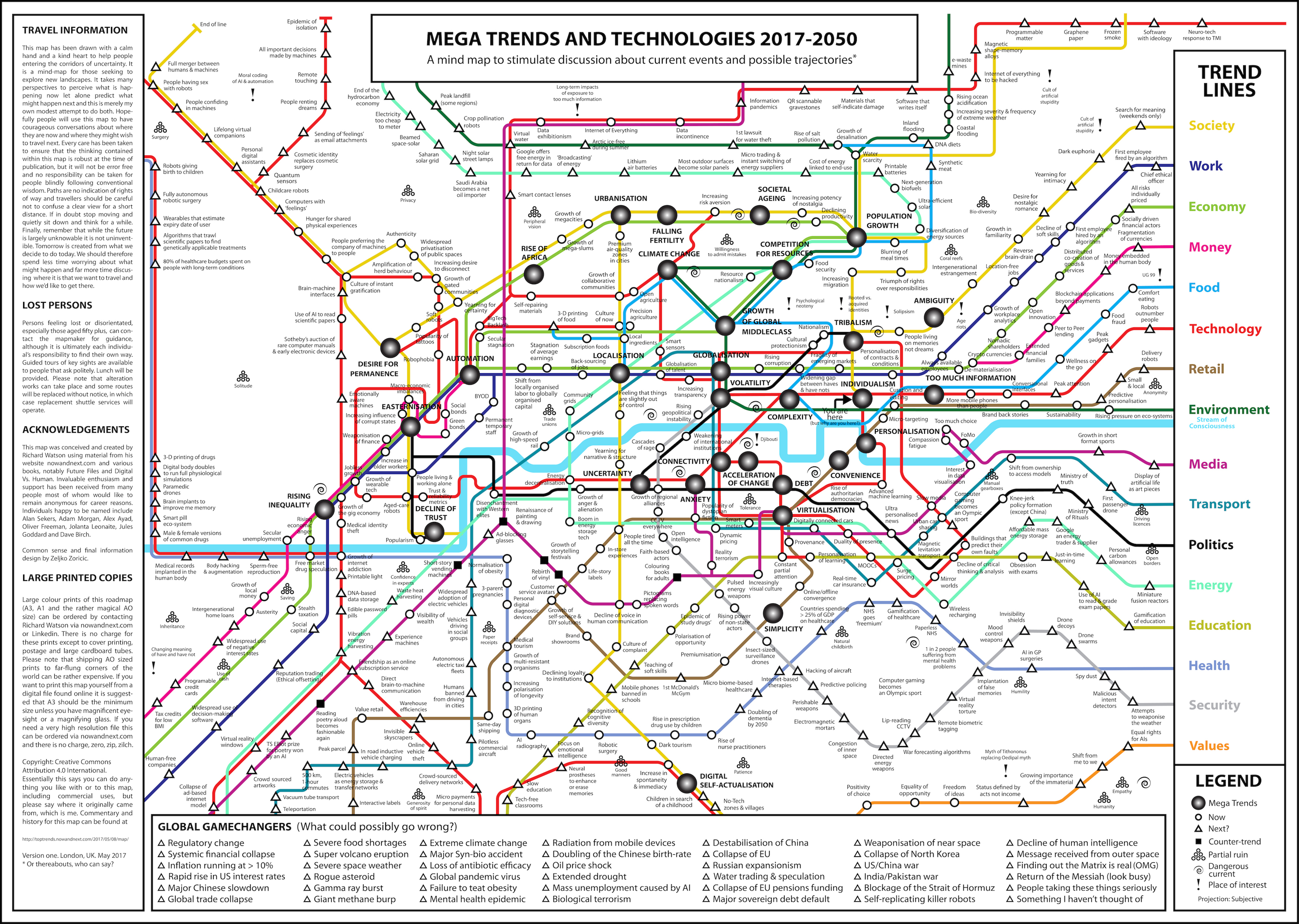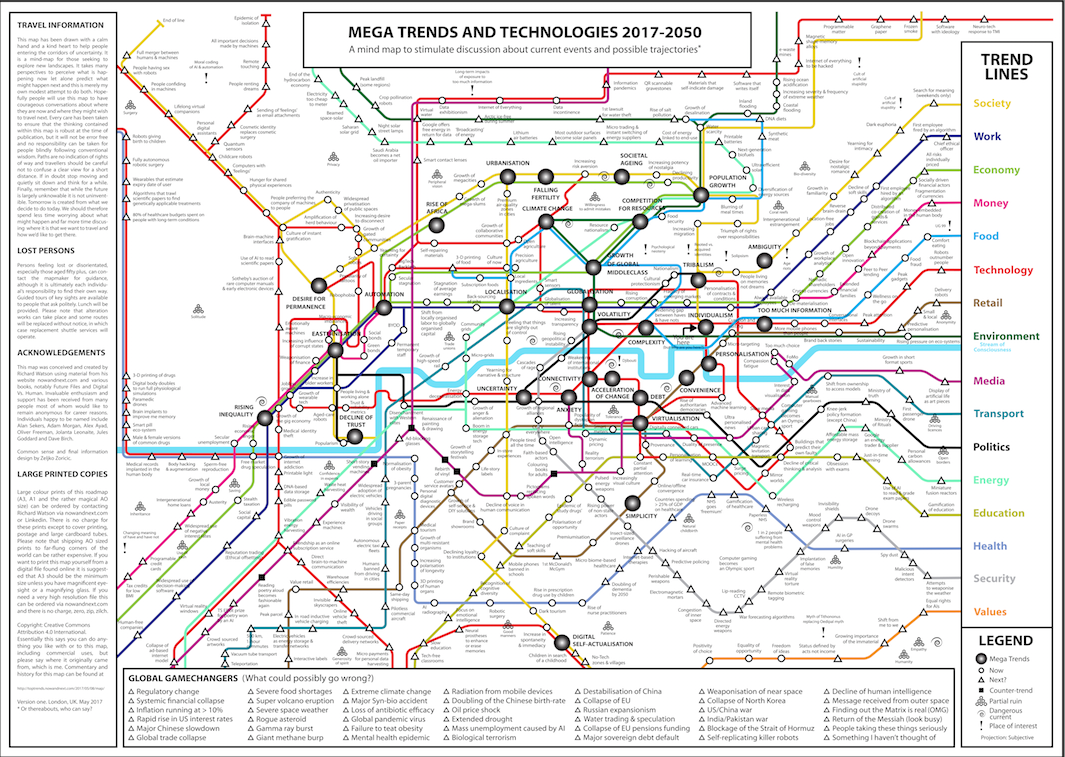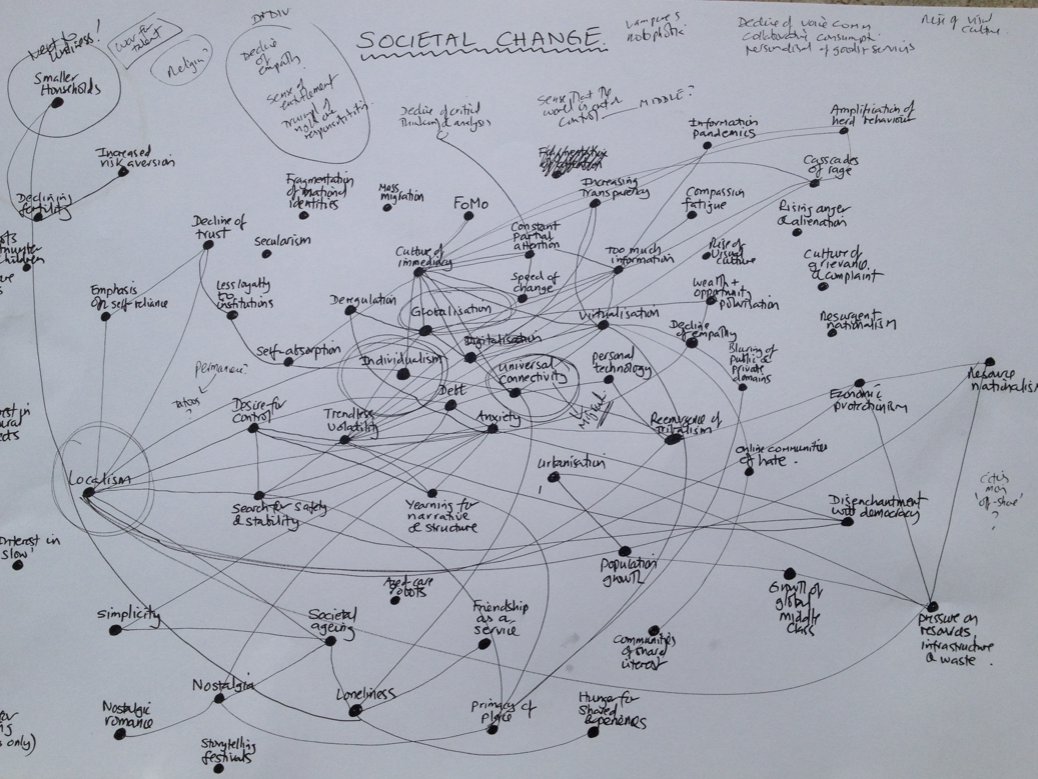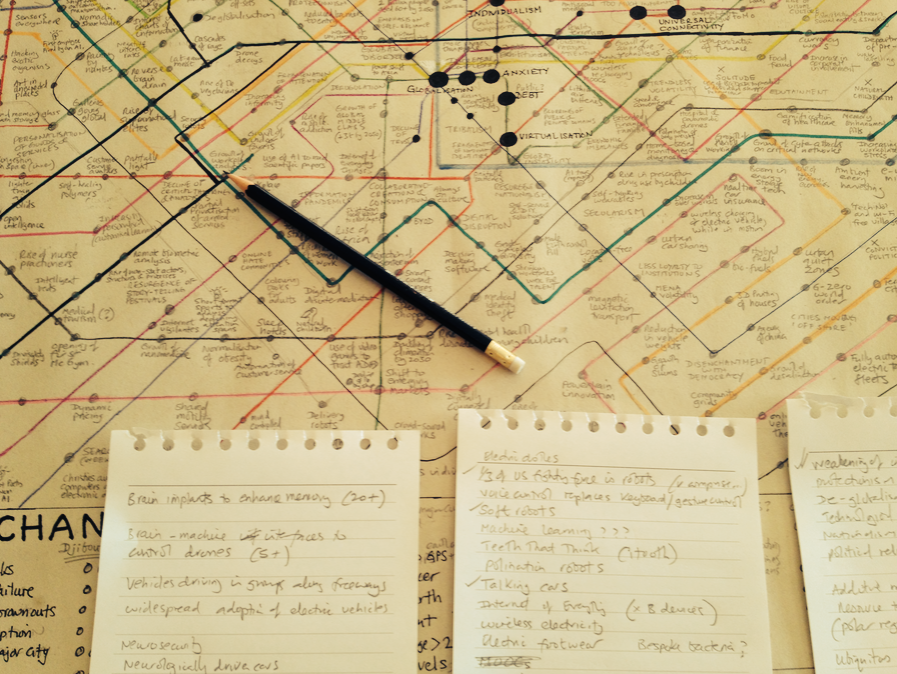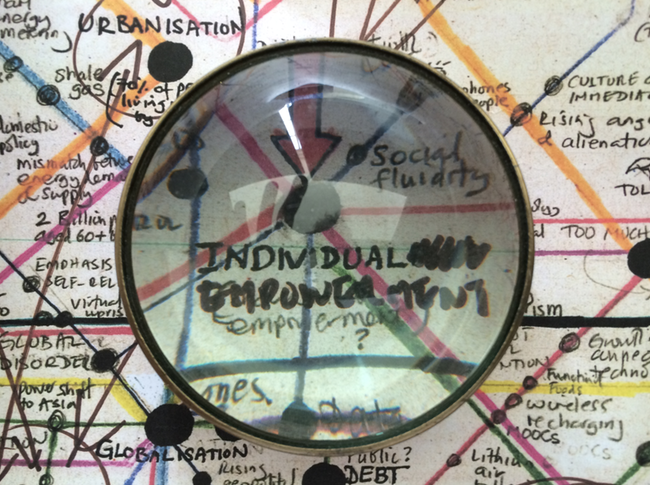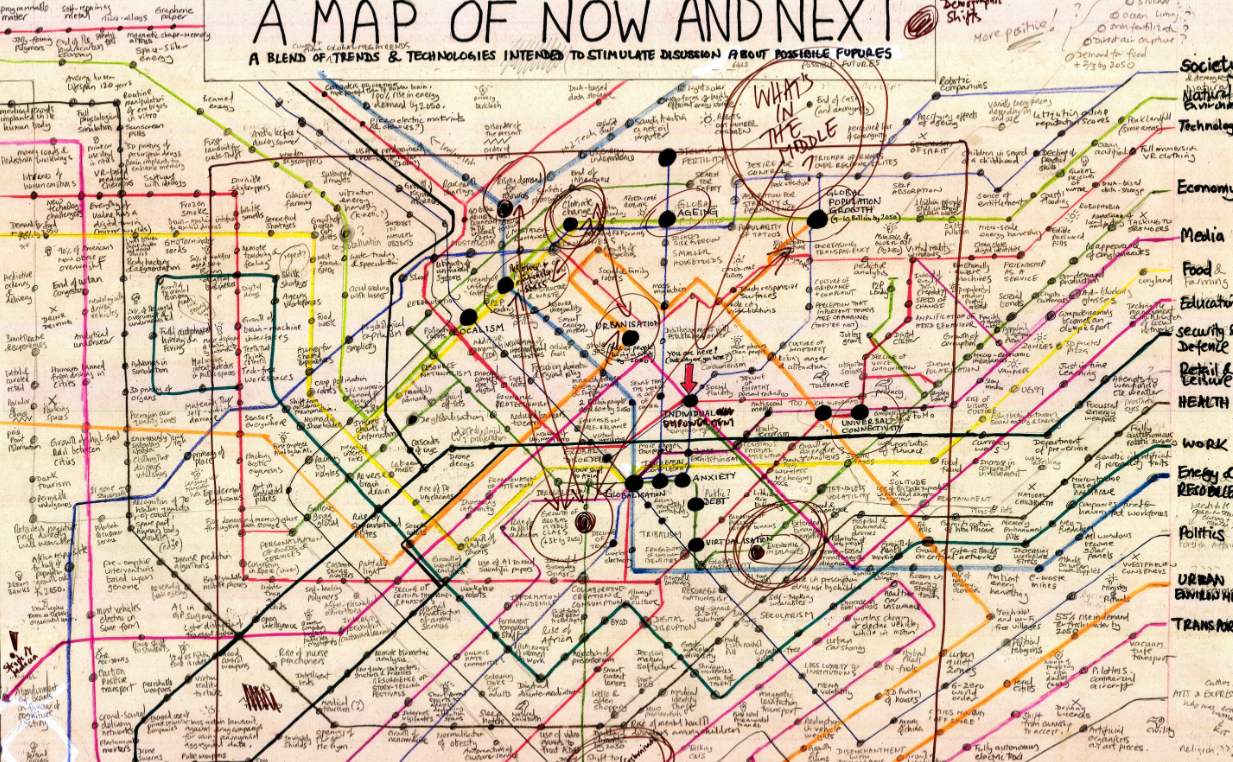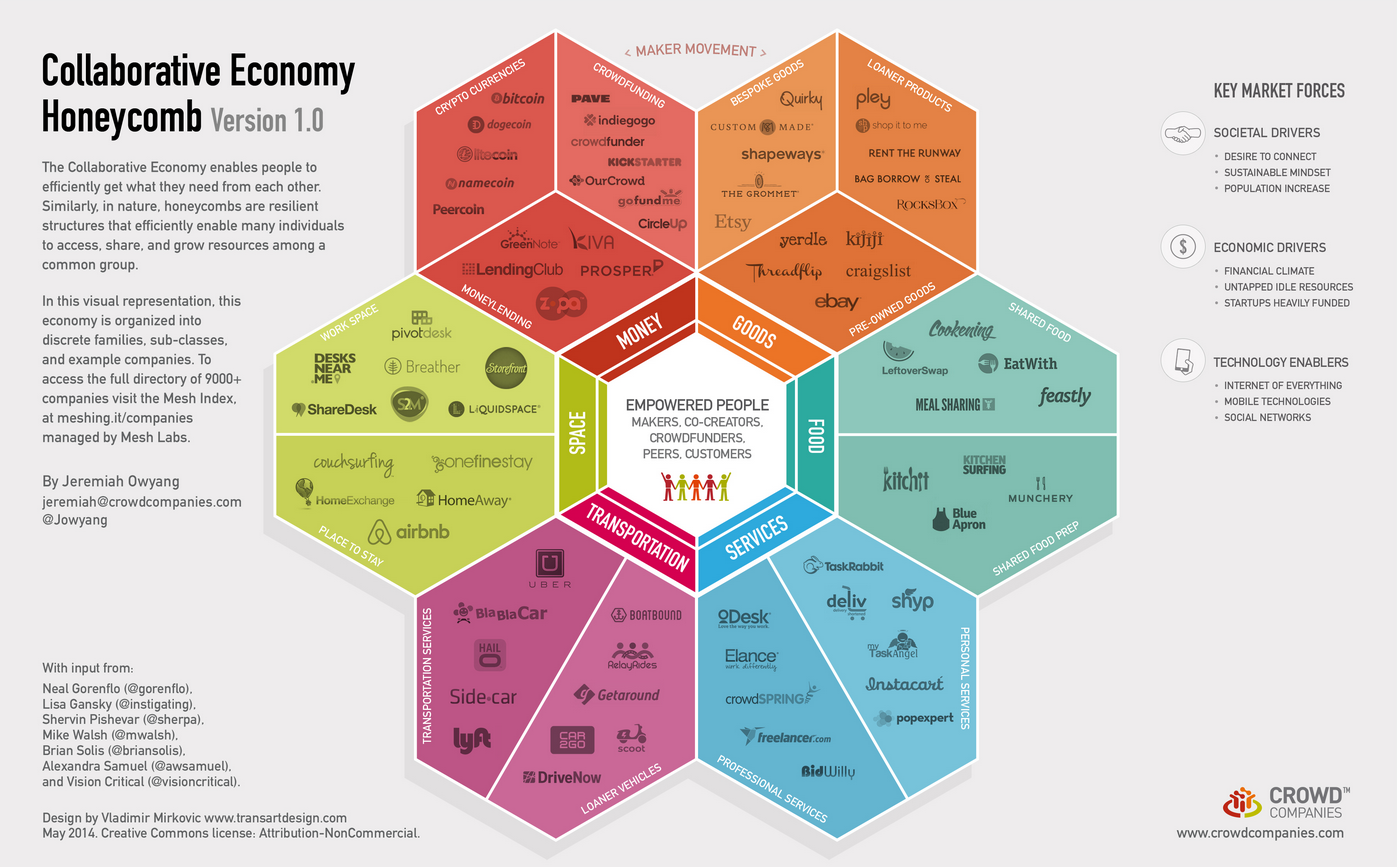Here you go then. Use this link to get to a high resolution version. A3, A1 and rather wonderful AO sized copies on paper are available upon request (no charge except for print, post and a cardbaord tube). See you in the future.
Tag Archives: mega-trends
Map
So here is a little background and commentary to my 2017 Mega Trends & Technologies map. This map began as an idea way back in 2015, but it wasn’t until early 2016 that I started to draw various outlines of what the map might look like.Eventually I settled on a look based on an earlier map I created in 2010. The initial thinking was very much about what the individual lines might represent and then obviously what to put on the lines and in particular the connection points (which took ages).
The mega trends were the first thing to get worked out. I had a gut feel about this already, but researched various publications to extend my thinking. These sources included work done by the MOD GST folks (Global Strategic Trends to 2040), the US National Intelligence Council (NIC) report on 2030, the OECD Science, Technology and Innovation Outlook 2016, Shell Scenarios and various reports by PWC, EY, KPMG and McKinsey. The main mega trends (about ten) broadly link with the mega trends contained within these reports, although I added a quite a few of my own to stir things up.
The final list of mega trends on the map (31 of them) are thus: population growth, urbanisation, rise of Africa, automation, globalisation, Easternisation, localisation (the same size as globalisation quite deliberately), climate change, falling fertility, societal ageing, competition for resources, growth of the global middle class, rising inequality, tribalism, ambiguity, individualism, volatility, complexity, personalisation, too much information, convenience, virtualisation, debt, connectivity, acceleration of change, uncertainty, desire for permanence, decline of trust, anxiety, simplicity, and digital self-actualisation.
I had a big think about what should be in the middle of the map. In the end it was a connectivity, closely aligned with globalisation, acceleration of change, anxiety and volatility. Individualism was almost in the centre, but I had a long debate with myself about whether this was quite the right word. The NIC has Individual Empowerment as a mega trend, and this was tempting, as was Solipsism. In the end it was just plain individualism.
The lines radiating into or out of the centre (depending on how you read it) ended up being fairly familiar. They are society, work, economy, money, food, technology, retail, environment, media, transport, politics, energy, education, health, security and values. That last one was a last minute addition. Originally it was religion, then it became death (!) and then identity. I would have liked more time on this and may extend the line in any future versions.
The icons on the map are ‘mega trends’, ‘now’ (which means a current trend) and ‘next’ (meaning a future idea, innovation, event or trend). I also added ‘counter-trends’, ‘partial ruins’ (things that are dying out or in a state of decay), ‘dangerous currents’ and ‘places of interest’. Broadly ‘now’ (call it 2017-2020) is in the middle of the map and the future (‘next’) radiates outwards. All of the entries are serious and there’s a solid argument behind each and every one, but some are also intended to provoke, For example, the idea of wearables that display the predicted death date of the user is simply an extension of what’s going on now with a bit of gamification and exaggeration thrown in.
At the bottom of the map there are a series of global game changers. These are broadly mega risks (x-risks) and by their nature rather negative. It would be interesting to do the map again and have this section about hugely impactful positive events, but that’s really quite hard to think of that many (like trying to think of utopian rather than dystopian sci-fi). BTW, I had ‘Donald Trump really is President’ as a global risk in this section ages ago, but obviously had to take him off when this really happened! (See image).
So what’s the map for? It’s really just what’s in my head right now (May 2017). Hopefully it will spark some debate and make people think, especially about where we, as a world, might be heading. If you like the map you might enjoy a couple of other important sources, namely two of my books Future Files and especially Digital Vs. Human. Thank you for reading.
PS – There’s a lovely mistake on the map that I might just keep on. I added Cult of Artificial Stupidity as a place of interest – but I added it twice.
Finally (but probably not) here’s a link to some of the things that never made it onto the map or were taken off (i.e. trends and future predictions)
Map of the Future
So I’ve got seriously stuck on what’s in the middle of my new map of future trends and technologies. It’s been individualism for a while. Then I changed this to individual empowerment, which the National Security Agency (US) uses. This is just too postive or at least unbalanced. Solipsism is really close, but nobody knows what this is I fear. Rise of the individual isn’t bad and gives a direction. But I just can’t get the word or phrase right. Any got any ideas?
BTW, LOL. Got an email on Sunday from the World Future Society about a meeting on Monday about setting up a London chapter. You’d think, being a society about the future, that they might have given more than 24-hours notice.
The Future of Money (and everything else for that matter)
I’ve been silent for a while. A month in fact, which is almost certainly a record. I don’t know if it’s just me, but I’m drowning in information and ideas and the only solution seems to be disconnection, which is perhaps a kind of deliberate ignorance.
Anyway, I had a drink with Dave Birch yesterday (blog here) to talk about the future of money. It’s input into my new map of mega-trends. One of the most thought provoking 30 minutes in recent months. We covered everything from the weaponisation if finance (with historical examples) to the rise of disconnection technologies and synthetic staff. I also loved the idea that the money of the future will be much like the Neolithic (I’ll leave readers to figure that one out).
We talked quite a bit about community and the collaborative economy and this map (above) was something he showed me. Link to article about here.

